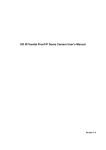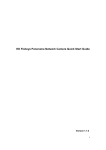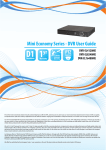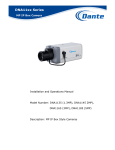Download HD IR Vandal Proof IP Dome Camera Quick Start Guide
Transcript
HD IR Vandal Proof IP Dome Camera Quick Start Guide Version 1.0 Welcome Thank you for purchasing our IP camera! This quick start guide is designed to be a reference tool for your system. Please keep this start guide well for future reference. Please open the accessory bag to check the items one by one in accordance with the list below. Contact your local retailer ASAP if something is missing or damaged in the bag. Before your operation please read the following instructions carefully. 1.Electrical safety All installation and operation here should conform to your local electrical safety codes. The power shall conform to the requirement in the SELV (Safety Extra Low Voltage) and the Limited power source is rated 12V DC or 24V AC in the IEC60950-1. We assume no liability or responsibility for all the fires or electrical shock caused by improper handling or installation. We are not liable for any problems caused by unauthorized modification or attempted repair. 2.Transportation security Heavy stress, violent vibration or water splash are not allowed during transportation, storage and installation. 3.Installation Do not apply power to the camera before completing installation. Please install the proper power cut-off device during the installation connection. Always follow the instruction guide the manufacturer recommended. 4.Qualified engineers needed All the examination and repair work should be done by the qualified service engineers. We are not liable for any problems caused by unauthorized modifications or attempted repair. 5.Environment This series IP camera should be installed in a cool, dry place away from direct sunlight, inflammable, explosive substances and etc. Please keep it away from the electromagnetic radiation object and environment. Please make sure the CCD (CMOS) component is out of the radiation of the laser beam device. Otherwise it may result in CCD (CMOS) optical component damage. Please keep the sound ventilation. Do not allow the water and other liquid falling into the camera. 6. Daily Maintenance Please shut down the device and then unplug the power cable before you begin daily maintenance work. Do not touch the CCD (CMOS) optic component. You can use the blower to clean the dust on the lens surface. Always use the dry soft cloth to clean the device. If there is too much dust, please use the water to dilute the mild detergent first and then use it to clean the device. Finally use the dry cloth to clean the device. Please put the dustproof cap to protect the CCD (CMOS) component when you do not use the camera. 7. Accessories Be sure to use all the accessories recommended by manufacturer. Before installation, please open the package and check all the components are included. Contact your local retailer ASAP if something is broken in your package. Accessory Name IPC Unit MD9M data converter cable Accessories bag Quick Start Guide Warranty Card Certificate Card CD Amount 1 1 1 1 1 1 1 Table of Contents 1 2 3 4 Framework...................................................................................................................................5 1.1 MD9M Data Converter Cable .....................................................................................5 1.2 Framework and Dimension.........................................................................................6 Installation ...................................................................................................................................8 2.1 Device Installation ........................................................................................................8 2.2 SD Card Installation ...................................................................................................11 2.3 Lens Adjustment.........................................................................................................12 Quick Configuration Tool.........................................................................................................13 3.1 Overview ......................................................................................................................13 3.2 Operation .....................................................................................................................13 Web Operation..........................................................................................................................16 4.1 Network Connection...................................................................................................16 4.2 Login and Logout........................................................................................................16 Appendix Toxic or Hazardous Materials or Elements ...............................................................19 1 Framework 1.1 MD9M Data Converter Cable You can refer to the following figure for MD9M data converter cable information. See Figure 1-1. Figure 1-1 Please refer to the following sheet for detailed information. Port Name Function Connection Note VIDEO OUT Video port output BNC Output analog video signal. It can connect to the TV monitor to view the video. AUDIO IN Audio port input RCA Input audio signal. It can receive the analog audio signal from the pickup. AUDIO OUT Audio port output RCA Output audio signal to the devices such as the sound box. 12V DC/AC24V Power port input / Power port. Input DC 12V/AC 24V I/O I/O cable port / Connect to MD9M data converter cable. LAN Network port Ethernet port Connect to standard Ethernet cable. Please refer to the follow sheet for detailed information of MD9M data converter cable. Port Name Cable Color Name Note I/O Pin Yellow RS485_A RS485_A port. It is to control the PTZ. Black RS485_B RS485_B port. It is to control the PTZ. Red ALARM_COM Alarm output public port. Brown ALARM_IN1 Alarm input port 1. It is to receive the on-off signal from the external alarm source. Grey ALARM_IN2 Alarm input port 2. It is to receive the on-off signal from the external alarm source. Port 5 Port Name Cable Color White Name ALARM_NO Note Alarm output port. It is to output the alarm signal to the alarm device. NO: normal open alarm output port. It works with the ALARM_COM port. It is to restore factory default setup. Blue RESET Orange GND When the device is working properly, please connect the blue cable (restore default setup port) to the orange cable (GND signal) for 5 seconds, the device can resume factory default setup. Ground port 1.2 Framework and Dimension Please refer to the following figure for dimension information. The unit is mm. See Figure 1-2 and Figure 1-3. Figure 1-2 6 Figure 1-3 7 2 Installation This series IPC can be put on the table to realize surveillance. Or you can use the bracket or the in-ceiling installation to realize the hang function. Please refer to the steps listed below. 2.1 Device Installation Step 1 Use the inner hexagonal wrench (provided) to loose the three inner hexagon screws in the dome cover and then open the cover. See Figure 2-1. Figure 2-1 Step 2 Use the inner hexagonal wrench (provided) to loose the three inner hexagon screws in the dome and then remove the device pedestal. See Figure 2-2. 8 Figure 2-2 Step 3 Draw out the cable exit and four screw holes in the installation position according to the device pedestal. Dig the four plastic expansion bolt hole and cable exit. Insert the four plastic expansion bolts into the screw holes Step 4 Adjust the camera pedestal to the proper position and then draw the cable through the cable exit you just dug in the ceiling (wall). Line up the four screw holes in the device pedestal to the four plastic expansion bolt holes in the installation position. Put the four self-tapping screws in the device pedestal and then use the screwdriver to secure the screws in the four plastic expansion bolts firmly. Step 5 Adjust the device position and line up the three inner hexagon screws of the device to the three holes of the installation position. Put the three inner hexagon screws into the screw holes at the bottom of the pedestal. Use the inner hexagon screwdriver to fix firmly. See Figure 2-3. 9 Figure 2-3 Step 6 Adjust the X-Y-Z axis module to turn the device to the proper monitor angle. Please follow the steps listed below to adjust. z Slightly loose the screws at the two sides of the X-Y-Z module manually, you can adjust the module tilt rotation angle (15°~90°). z Slightly loose the screw of the pressing slice, you can adjust the video rotation angle of the module (0°~355°) Adjust the turning ring of the pedestal, you can adjust the module pan rotation angle (0°~ 355°). Please note, the screws in the following figure are the optical adjustment component. Please make sure it is outward and do not allow it to touch the X-Y-Z axis module. See Figure 2-4 z Figure 2-4 Step 7 Put the dome cover back and then put the three inner hexagon screws into the holes of the device. Use the inner hexagonal wrench to fasten these three screws. See Figure 2-5 10 Figure 2-5 2.2 SD Card Installation Important Before you install the SD card, please unplug he power cable to shut down the device! First, please refer to the step1 in the chapter 2.1 to open the device. Second, please adjust the proper position to install the SD card. Last, please refer to the step 7 in the chapter 2.1 to complete the installation. See Figure 2-6. Figure 2-6 11 2.3 Lens Adjustment Step 1 Slightly loose the screw B manually and then turn the screw B slowly. Adjust the lens focus distance to the proper position according to the monitor video. See Figure 2-7. Step 2 Use the flat screwdriver to loose the screw A slightly and then turn the Screw A slowly. Adjust the lens focus to get the clear video and then use the flat screwdriver to secure the screw firmly. Step 3 When you are adjusting the screw A, the video may becomes blur. Please slightly adjust the screw B manually to get the vivid video. Finally fix the screw. Figure 2-7 12 3 Quick Configuration Tool 3.1 Overview Quick configuration tool can search current IP address, modify IP address. At the same time, you can use it to upgrade the device. Please note the tool only applies to the IP addresses in the same segment. 3.2 Operation Double click the “ConfigTools.exe”icon, you can see an interface is shown as in Figure 3-1. In the device list interface, you can view device IP address, port number, subnet mask, default gateway, MAC address and etc. Figure 3-1 Select one IP address and then right click mouse, you can see an interface is shown as in Figure 3-2. 13 Figure 3-2 Select the “Open Device Web” item; you can go to the corresponding web login interface. See Figure 3-3. Figure 3-3 If you want to modify the device IP address without logging in the device web interface, you can go to the configuration tool main interface to set. In the configuration tool search interface (Figure 3-1), please select a device IP address and then double click it to open the login interface. Or you can select an IP address and then click the Login button to go to the login interface. See Figure 3-4. In Figure 3-4, you can view device IP address, user name, password and port. Please modify the corresponding information to login. Please note the port information here shall be identical with the port value you set in TCP port in Web Network interface. Otherwise, you can not login the device. If you are use device background upgrade port 3800 to login, other setups are all invalid. Figure 3-4 After you logged in, the configuration tool main interface is shown as below. See Figure 3-5. 14 Figure 3-5 For detailed information and operation instruction of the quick configuration tool, please refer to the Quick Configuration Tool User’s Manual included in the resources CD. 15 4 Web Operation This series IPC product support the Web access and management via PC. Web includes several modules: monitor channel list, record search, alarm setup, system configuration, PTZ control, monitor window and etc. IP camera factory default setup: z IP address: 192.168.1.108. z User name: admin z Password: admin 4.1 Network Connection Please follow the steps listed below for network connection. z Make sure the IPC has connected to the network properly. z IPC IP address and PC IP address shall be in the same network segment. IPC default IP address is 192.168.1.108. If there is router, please set the corresponding gateway and subnet mask. z Use order ping ***.***.***.***(* IP camera address) to check connection is OK or not. 4.2 Login and Logout Open IE and input IP camera address in the address bar. For example, if your camera IP is 192.168.1.108, then please input http:// 192.168.1.108 in IE address bar. See Figure 4-1. Input your IP address here Figure 4-1 System pops up warning information to ask you whether install control webrec.cab or not. Please click OK button, system can automatically install the control. When system is upgrading, it can overwrite the previous Web too. If you can’t download the ActiveX file, please check whether you have installed the plug-in to disable the control download. Or you can lower the IE security level. See Figure 4-2. 16 Figure 4-2 After installation, the interface is shown as below. See Figure 4-3. Please input your user name and password. Default factory name is admin and password is admin. Note: For security reasons, please modify your password after you first login. Figure 4-3 After you logged in, you can see the main window. See Figure 4-4. 17 Figure 4-4 Please refer to the HD IR Vandal Proof IP Dome Camera Web Operation Manual included in the resource CD for detailed operation instruction. 18 Appendix Toxic or Hazardous Materials or Elements Component Name Toxic or Hazardous Materials or Elements Pb Hg Cd Cr VI PBB PBDE Circuit Board Component ○ ○ ○ ○ ○ ○ Device Construction Material ○ ○ ○ ○ ○ ○ Wire and Cable ○ ○ ○ ○ ○ ○ ○ ○ ○ ○ ○ ○ ○ ○ ○ ○ ○ ○ Packing Components Accessories O: Indicates that the concentration of the hazardous substance in all homogeneous materials in the parts is below the relevant threshold of the SJ/T11363-2006 standard. X: Indicates that the concentration of the hazardous substance of at least one of all homogeneous materials in the parts is above the relevant threshold of the SJ/T11363-2006 standard. During the environmental-friendly use period (EFUP) period, the toxic or hazardous substance or elements contained in products will not leak or mutate so that the use of these (substances or elements) will not result in any severe environmental pollution, any bodily injury or damage to any assets. The consumer is not authorized to process such kind of substances or elements, please return to the corresponding local authorities to process according to your local government statutes Note: z This quick start guide is for reference only. Slight difference may be found in user interface. z All the designs and software here are subject to change without prior written notice. z If there is any uncertainty or controversy, please refer to the final explanation of ours. z Please visit our website or contact your local service engineer for more information. 19


































